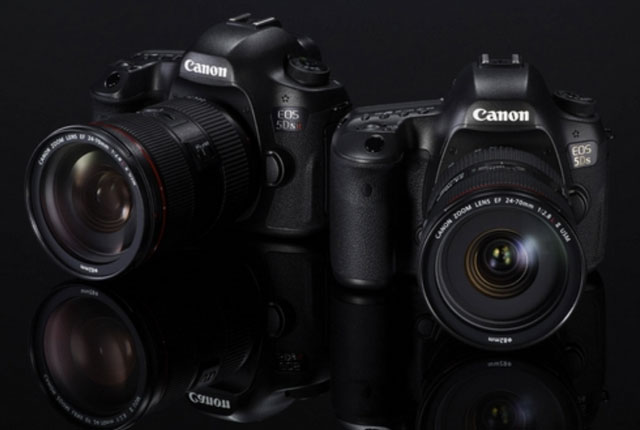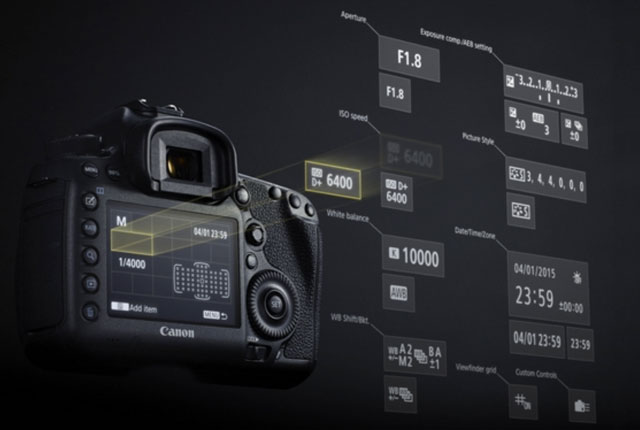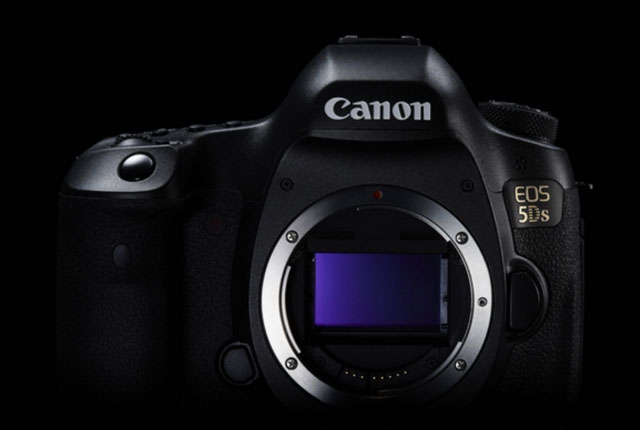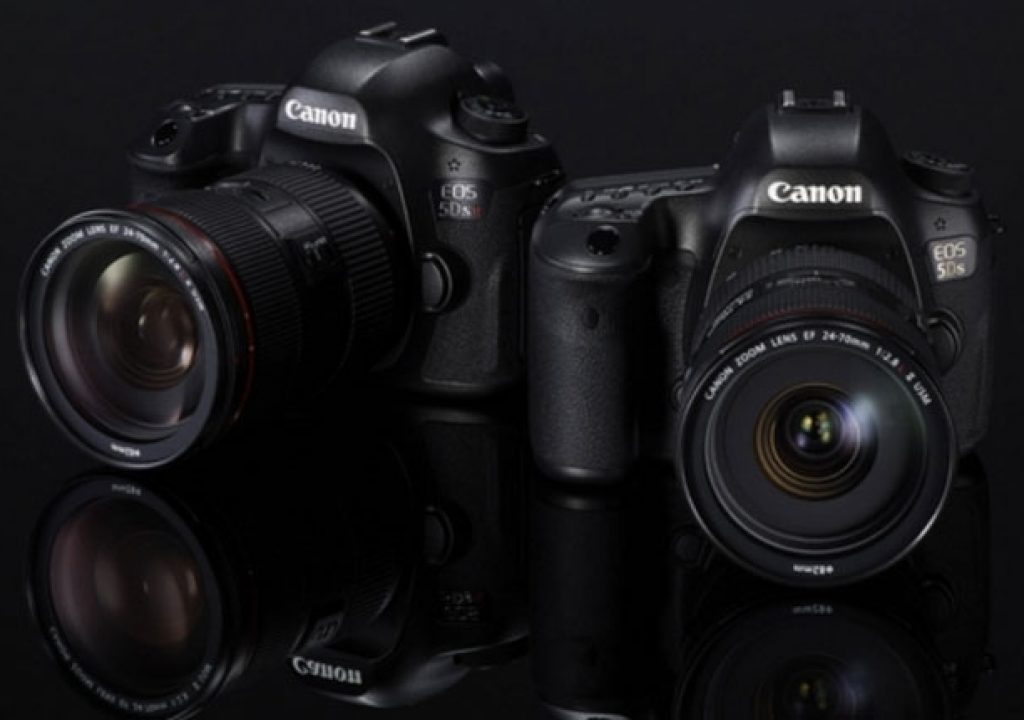
One could almost say that cinematographers can pass this one: Canon slimmed down the video and enhanced the photographic aspects of their new camera(s). But it is not quite as simple as that.
The Canon EOS 5Dsi and Canon EOS 5DS Ri are the two new cameras from Canon, an answer to all those that asked for millions of pixels. Now they have 50.6MP. Regarding video, this is more of the same: 1080p Full HD up to 30p or 720p HD video up to 60p.
Said like this, I can hear those that dreamd of 4K – and why not 8K? – stating the model is condemned from the start, while they look elsewhere, already. Well, maybe this is part of Canon’s strategy. They did not create a shadow over their own EOS 5D Mark III, which is a different beast all together, and they may well be paving the way for their Cinema EOS line. So the new models are missing some options in the video department, like they lack a headphone jack or HDMI out port.
In creating two top of the line DSLR, Canon seems to be also doing something many people tend to forget. They give an answer to those photographers that have been asking for a DSLR with less video and more photographic options. Yes, there is still people photographing, so it makes sense to look at them and their needs, as photographers are a species that has been responsible for the success of Canon. So there you’ve it, this is mainly a camera for photographers. That happen to also do video.
 So, in terms of video capabilities, the Canon is “business as usual”. As Canon states in their information, “the EOS 5DS and EOS 5DS R cameras continue the EOS Movie tradition with the ability to shoot in 1080p Full HD up to 30p or 720p HD video up to 60p”. Now, what’s interesting, even for people doing video, is that the camera includes a “creative Time Lapse Movie function, a first for EOS cameras, takes a continuous series of still photographs and automatically combines them in camera into a Full HD movie file. Interval adjustments can be set from one second to 99 hours, 59 minutes and 59 seconds. The number of shots possible range from 2 to 3,600 with a maximum of two minutes and 30 seconds of playback time. In addition, high-speed continuous shooting up to five-frames-per-second (fps) at full 50 megapixel resolution allows users to capture fast action.” So, all those time-lapsers out there may be interested into looking at the two cameras.
So, in terms of video capabilities, the Canon is “business as usual”. As Canon states in their information, “the EOS 5DS and EOS 5DS R cameras continue the EOS Movie tradition with the ability to shoot in 1080p Full HD up to 30p or 720p HD video up to 60p”. Now, what’s interesting, even for people doing video, is that the camera includes a “creative Time Lapse Movie function, a first for EOS cameras, takes a continuous series of still photographs and automatically combines them in camera into a Full HD movie file. Interval adjustments can be set from one second to 99 hours, 59 minutes and 59 seconds. The number of shots possible range from 2 to 3,600 with a maximum of two minutes and 30 seconds of playback time. In addition, high-speed continuous shooting up to five-frames-per-second (fps) at full 50 megapixel resolution allows users to capture fast action.” So, all those time-lapsers out there may be interested into looking at the two cameras.
Two cameras. Why two cameras? I guess you asked, so where is the answer. Canon is following on the steps of Nikon with their D800 model: one camera has a anti-aliasing filter, the other not. Or better one of them cancels the effect of the filter that is already there. As Canon states, “maximizing the potential of the new 50.6 megapixel sensor – for the first time in an EOS camera the low-pass filter effect in the EOS 5DS R model is cancelled. The cancellation of the low-pass filter helps deliver sharp images, squeezing the most out of every pixel. Both models provide attractive options for medium format shooters especially when coupled with a wide array of over 70 creative Canon EF lenses to choose from.”
Both cameras have a new sensor model from Canon, and not the so much rumored Sony sensor some said they would have. This new 50.6 MP sensor places Canon in a comfortable position on the ever continuing war of more pixels – this is now the world’s highest resolution sensor among 35mm format DSLRs -, while providing the means for an interesting new feature that Canon adopted and may well suite those that want to do video and still think the Full HD available on these models is enough for them. In fact, having so many pixels has at least one advantage: with such abundant resolution on each sensor, both models provide two cropped shooting modes, while still delivering high-resolution images 30.5 megapixels for the 1.3x mode and 19.6 megapixels for the 1.6x mode, which allow for large-format printing and extensive cropping capability while maintaining high image quality. The available crop options are visible as a mask or an outline in the viewfinder; so shooters can know exactly where to frame their subject. If this crop works for video, it can be an interesting option. And the cameras offer a new Picture Style called “Fine Detail”, which has been added to enhance the sharpness of JPEGs and EOS Movies with three new settings: Strength, Fineness and Threshold.
Because these are essentially photographic tools, it makes sense to mention some of the aspects implemented. In addition to the 50.6 megapixel full-frame image sensor and Dual DIGIC 6 Image Processors, both cameras include a 61-Point High Density Reticular AF array including up to 41 cross-type AF points and EOS iTR AF for high precision autofocus. They also include the EOS Scene Detection system featuring a 150,000-pixel RGB+IR 252-zone metering sensor that provides enhanced precision and performance.
In support of such a high-resolution imaging sensor, the EOS 5DS and EOS 5DS R cameras were designed to minimize camera shake and significantly improve stability via a reinforced chassis, baseplate and tripod lug to improve rigidity. Canon also re-designed the mirror vibration control system to help reduce mirror bounce and camera shake. To help maximize stability and minimize vibrations, Canon added a new Arbitrary Release Time Lag Setting in Mirror Lock mode in both models. In addition to the standard setting (press the shutter button once to lock the mirror, then again to release the shutter), the EOS 5DS and EOS 5DS R cameras offer new setting intervals of 1/8, 1/4, 1/2, one and two seconds, releasing the shutter after the selected preset delay, allowing potential camera vibration to dissipate before shutter release.
Like the EOS 7D Mark II, the EOS 5DS and EOS 5DS R cameras feature an advanced AE system that can detect and compensate for flickering light sources such as sodium vapor lamps that are often used in gymnasiums and auditoriums. When enabled, this anti-flicker system automatically adjusts shutter release timing to help reduce disparities in exposure and color especially during continuous shooting. And new Auto White Balance settings include Ambience Priority and White Priority (for use when shooting under tungsten lighting).
 Conceived for commercial, studio, portrait, landscape and architectural photography, or anyone looking for an affordable alternative to medium format, the ultra-high resolution of these new modelsis interesting for photographers and cinematographers, who will appreciate improved custom controls including a built-in intervalometer and bulb timer to enable the capture of time-lapse images and long-exposure images. These features are ideal for recording fireworks, star trails, sunrises and more.
Conceived for commercial, studio, portrait, landscape and architectural photography, or anyone looking for an affordable alternative to medium format, the ultra-high resolution of these new modelsis interesting for photographers and cinematographers, who will appreciate improved custom controls including a built-in intervalometer and bulb timer to enable the capture of time-lapse images and long-exposure images. These features are ideal for recording fireworks, star trails, sunrises and more.
“Canon is always looking to deliver the absolute best in image quality and push our technology to the limits. These cameras deliver on that pledge, providing photographers with two new incredible tools that will enable them to make the most out of every shoot,” said Yuichi Ishizuka, president and COO, Canon U.S.A., Inc. “As photography becomes more specialized and more images are captured than ever before, the burden is on the photography equipment to keep up with the demands of today’s artistic talents. These new camera models will provide many photographers with new options to deliver their vision to clients, fans, and the world.”
The EOS 5DS and EOS 5DS R cameras feature dual card slots for CF and SD memory cards, including Ultra High Speed (UHS-1) SD cards. Built to last, the cameras also feature a shutter durability rating up to 150,000 cycles, the same as the EOS 5D Mark III.
The EOS 5DS and EOS 5DS R Digital SLR cameras are scheduled to be available through authorized Canon dealers in June 2015 for estimated retail prices of $3,699.00 and $3,899.00 for the body only, respectively.

Filmtools
Filmmakers go-to destination for pre-production, production & post production equipment!
Shop Now













